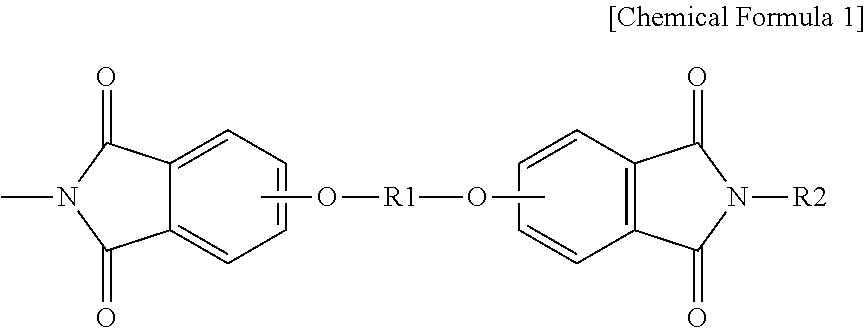Electrically charged nonwoven fabric, filtration material including same, and method for producing electrically charged nonwoven fabric
a technology of nonwoven fabric and filtration material, which is applied in the direction of membrane technology, filtration separation, separation process, etc., can solve the problems of poor heat resistance of electrically charged nonwoven fabrics including polypropylene fibers, poor heat resistance of heat-resistant filters of this type, and poor handleability of electrically charged nonwoven fabrics. , to achieve the effect of improving performance, excellent collection efficiency and low pressure loss
- Summary
- Abstract
- Description
- Claims
- Application Information
AI Technical Summary
Benefits of technology
Problems solved by technology
Method used
Image
Examples
example 1
[0082]An amorphous polyetherimide (glass transition temperature, 215° C.) was spun at a spinning temperature of 420° C. into a melt-blown nonwoven fabric that had a basis weight of 25 g / m2 and an average fiber diameter of 2.2 μm. Subsequently, calender treatment was conducted at a roll temperature of 200° C. and a contact pressure of 30 kg / cm, followed by voltage application with a direct-current high-voltage stable power supply (manufactured by Kasuga Electric Works Ltd.) by the corona discharge method under conditions of a distance between electrodes of 20 mm, a voltage of 30 kV, a temperature of 30° C., and a duration of 3 seconds. Physical properties of the resulting electrically charged nonwoven fabric are shown in Table 1.
example 2
[0083]An amorphous polyetherimide (glass transition temperature, 215° C.) was spun at a spinning temperature 435° C. into a spunbonding nonwoven fabric that had a basis weight of 25 g / m2 and an average fiber diameter of 5.1 μm. Subsequently, calender treatment was conducted at a roll temperature of 200° C. and a contact pressure of 30 kg / cm, followed by voltage application with a direct-current high-voltage stable power supply (manufactured by Kasuga Electric Works Ltd.) by the corona discharge method under conditions of a distance between electrodes of 20 mm, a voltage of 30 kV, a temperature of 30° C., and a duration of 3 seconds. Physical properties of the resulting electrically charged nonwoven fabric are shown in Table 1.
example 3
[0084]An amorphous polyetherimide (glass transition temperature, 215° C.) was spun at a spinning temperature of 420° C. into a melt-blown nonwoven fabric that had a basis weight of 25 g / m2 and an average fiber diameter of 2.5 μm. Subsequently, calender treatment was conducted at a roll temperature of 200° C. and a contact pressure of 80 kg / cm, followed by voltage application with a direct-current high-voltage stable power supply (manufactured by Kasuga Electric Works Ltd.) by the corona discharge method under conditions of a distance between electrodes of 20 mm, a voltage of 30 kV, a temperature of 30° C., and a duration of 3 seconds. Physical properties of the resulting electrically charged nonwoven fabric are shown in Table 1.
PUM
| Property | Measurement | Unit |
|---|---|---|
| particle diameter | aaaaa | aaaaa |
| glass transition temperature | aaaaa | aaaaa |
| diameter | aaaaa | aaaaa |
Abstract
Description
Claims
Application Information
 Login to View More
Login to View More - R&D
- Intellectual Property
- Life Sciences
- Materials
- Tech Scout
- Unparalleled Data Quality
- Higher Quality Content
- 60% Fewer Hallucinations
Browse by: Latest US Patents, China's latest patents, Technical Efficacy Thesaurus, Application Domain, Technology Topic, Popular Technical Reports.
© 2025 PatSnap. All rights reserved.Legal|Privacy policy|Modern Slavery Act Transparency Statement|Sitemap|About US| Contact US: help@patsnap.com


